Memories of 9/11
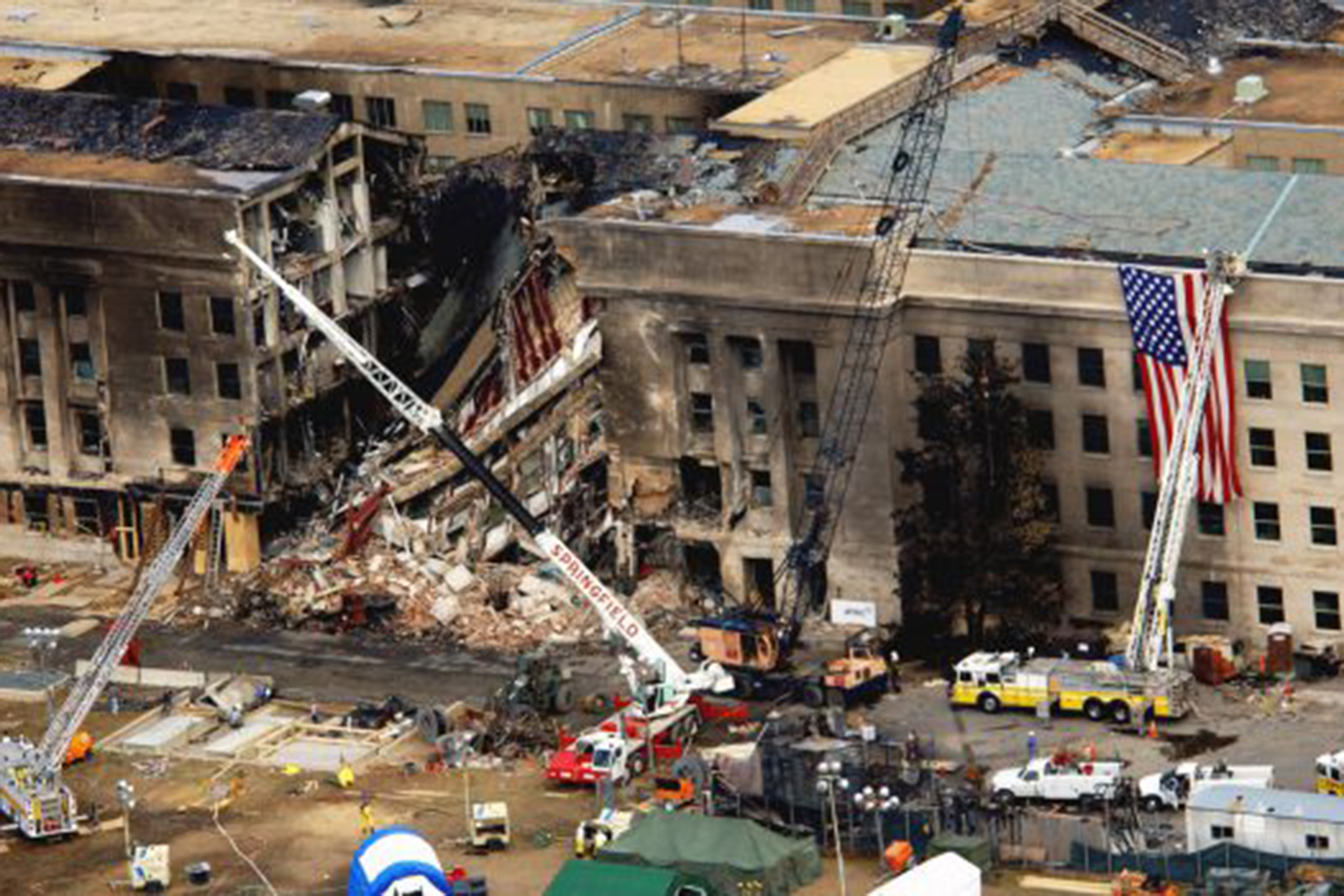 To mark the 20th anniversary of the September 2001 terrorists’ attacks, I would like to share the memories of eight members of Cherrydale United Methodist in Arlington, Virginia. Our hope is that by recalling how we felt then, we can give thanks for the relative safety we have enjoyed since then and find ways to collaborate for positive change. To begin, we review the timeline. That morning 19 hijackers took control of four commercial airliners–large planes prepared for long flights and full of fuel.
To mark the 20th anniversary of the September 2001 terrorists’ attacks, I would like to share the memories of eight members of Cherrydale United Methodist in Arlington, Virginia. Our hope is that by recalling how we felt then, we can give thanks for the relative safety we have enjoyed since then and find ways to collaborate for positive change. To begin, we review the timeline. That morning 19 hijackers took control of four commercial airliners–large planes prepared for long flights and full of fuel.
- American Airlines Flight 11: a Boeing 767 aircraft, departed Logan Airport In Boston at 7:59 a.m. en route to Los Angeles with a crew of 11 and 76 passengers, not including five hijackers. The hijackers flew the plane into the northern facade of the North Tower of the World Trade Center in New York City at 8:46 a.m.
- United Airlines Flight 175: a Boeing 767 aircraft, departed Logan Airport at 8:14 a.m. en route to Los Angeles with a crew of nine and 51 passengers, not including five hijackers. The hijackers flew the plane into the southern facade of the South Tower of the World Trade Center in New York City at 9:03 a.m.
- American Airlines Flight 77: a Boeing 757 aircraft, departed Washington Dulles International Airport at 8:20 a.m. en route to Los Angeles with a crew of six and 53 passengers, not including five hijackers. The hijackers flew the plane into the western facade of the Pentagon in Arlington County, Virginia, at 9:37 a.m.
- United Airlines Flight 93: a Boeing 757 aircraft, departed Newark International Airport at 8:42 a.m. en route to San Francisco, with a crew of seven and 33 passengers, not including four hijackers. As passengers attempted to subdue the hijackers, the aircraft crashed near Shanksville, Pennsylvania, at 10:03 a.m.
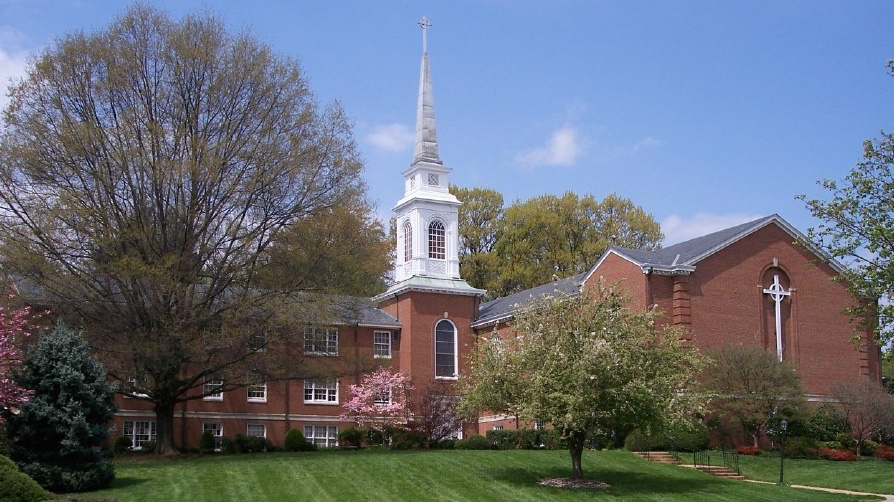 Many members of Cherrydale United Methodist Church, 3701 Lorcom Lane, Arlington, Virginia, located within the 4-mile radius of the White House, recall September 11 vividly. Twenty years later, eight of us agreed to put our memories in writing, in order to share what we experienced with current Cherrydale members and with the Arlington Historical Society. Our pastor at the time, Larry Buxton, who lived in the parsonage on Nellie Custis Drive, begins our account.
Many members of Cherrydale United Methodist Church, 3701 Lorcom Lane, Arlington, Virginia, located within the 4-mile radius of the White House, recall September 11 vividly. Twenty years later, eight of us agreed to put our memories in writing, in order to share what we experienced with current Cherrydale members and with the Arlington Historical Society. Our pastor at the time, Larry Buxton, who lived in the parsonage on Nellie Custis Drive, begins our account.
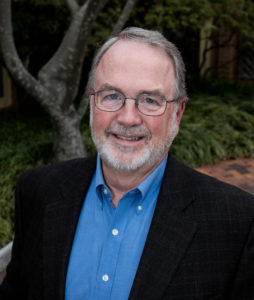
Larry Buxton. As I got ready to walk across the street for our usual Tuesday morning staff meeting, I watched the horrific news on television. While the meeting was important, it was hard to leave the news. Most of the other staff members felt the same way and were glued to their televisions at home. Katie Couric on NBC’s Today Show was showing Jim Miklaszewski reporting from the Pentagon, when we all heard, and he clearly felt, the THUMP from the opposite side of the building. The plane struck while he was speaking.
I knew we needed to gather and pray that night. I wasn’t sure how talkative people would feel, what readings would be best, what music, and so forth — this was an unprecedented shock, and we were all flying blind, so to speak.
The next day, I drove across the Potomac River to Wesley Seminary at American University to assist Professor Kendall Soulen in their field education program (that later brought us Mark Mrini and Rachel McIver). Soulen had been driving up I-395 on Tuesday. As he passed the Pentagon, he saw the plane fly overhead and crash just a few hundred yards to his right. Driving home, I vividly remember the slow crawl south across Chain Bridge in the dusk, traffic moving so slowly that all of us drivers could see each other’s faces and glance into each other’s eyes. As I looked at my fellow drivers, I realized that none of us knew anything about each other. Each person approaching me on this narrow vulnerable bridge could be carrying a bomb or going to a terrorist meeting. Or they could be folks just ready to get back home to their families. They knew nothing about where I was headed either, and could have easily been as suspicious of me.
The September 11 attacks challenged the basic trust we live in with our fellow citizens. We can regard everyone with that momentary suspicion all the time, especially when seeing someone who looks different from us. Or we can risk trusting our unknown neighbors, being stunned by such acts of profound betrayal and hatred, and still determined to love God and love our neighbor. Being in a vulnerable place, a few short miles from the gaping hole in the Pentagon, now suspended on that bridge between home, church and seminary, uncertain yet slowly inching forward was a powerful metaphor for what I felt in September 2001.

It was Chet and Andrea Davis, whom I visited last April in Atlantic Beach FL, who inspired this collection of memories. On 9/11 they were at the base of Mount Denali in Alaska on a Grand Circle tour. Because of the time zone difference, they first heard the news when they awoke at 7:00 am, or Noon, Eastern time. Air traffic and trains were immediately canceled, as they all transversed military installations, so they were taken by bus to the Chena River Lodge in Fairbanks, where they ended up spending a week. They returned to Dulles Airport on September 18.
On September 12, Grand Circle arranged a “home visit,” matching five or six travelers with volunteer hosts. Greg Johnson, a retired pediatric dentist, and his wife Ann hosted Chet and Andrea’s group. Chet said “The salmon they served that night were the best I ever tasted! They were caught that morning and grilled outdoors.”
Seeing that the Davises were stranded, the Johnsons offered them the use of one of their cars for as long as they needed it. Chet and Andrea drove the car to see many sites around Fairbanks. At the University of Alaska Arboretum, they saw the giant sunflowers that flourish in the long days of an Alaska summer. In the night sky, they saw the Aurora Borealis. They even drove across the Arctic Circle to the town of North Pole. Andrea recalled, “I didn’t want to be there a whole week, but I enjoyed every minute of it!.”
Soon after their return home, Chet and Andrea got busy. Andrea, a trained Red Cross volunteer, continued her work at the Fort Myer Ob/Gyn Clinic. She also commiserated with their friend and long-term houseguest, Matthew Bryant, who was a close friend of Charles Burlingame, the pilot of American Airlines flight 77.
The Arlington Police Department, where Chet had served as a volunteer Spanish translator for the previous three years, had a new job for him—scheduling deliveries and pick ups of food from local restaurants to provide sustenance for about 25 Police officers doing forensic analysis of the remains of 189 people killed at the Pentagon. Chet reports that his contacts were eager to help and especially generous, from five star restaurants to fast food outlets. “Whole Foods sent tons of baked goods each day; La Madeleine just asked how many meals to prepare.”
The forensic task was the sole responsibility of the Arlington Police Department. It was tough work and it took months. Chet kept up with many of the officers and found that within a year, many had retired with medical disability due to the emotional trauma of dealing with remains and artifacts.
Charles Horn. That morning, I attended a meeting at my children’s school, that ended shortly after 9:00. Then I got in my car and began driving south to meet a law client in Richmond. I thought of stopping for a cup of coffee, but decided against it. At about 9:30, I passed the Pentagon, unaware of what was about to happen there. I still wonder what I might have seen if I had stopped for that coffee. [Note: that face of the Pentagon had recently been reinforced; the tragedy could have been even worse.]
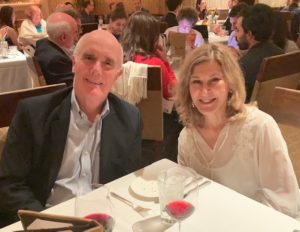
Jane called me during my drive south to tell me that a plane had flown into the World Trade Center, and my first thought was that this must have been some small aircraft that foolishly lost its way. With the client in Richmond we watched the collapse of the two towers and the pictures of the Pentagon. At lunch, no one said much. Mobile channels were totally jammed, but Jane got through by text to say she had arrived home safely—a great relief, though her long walk had completely worn out a pair of high heels. Her law office, a block from the White House, was hurriedly evacuated by the Secret Service, which had received warnings that the White House complex was a target for the last plane. Not permitted to retrieve their cars, she and her colleagues had to walk home from downtown Washington. As she crossed Key Bridge, they could see smoke rising from the Pentagon. The school I visited that morning, was near the Central Intelligence Agency; students were sent home early from fears that the CIA was also a target.
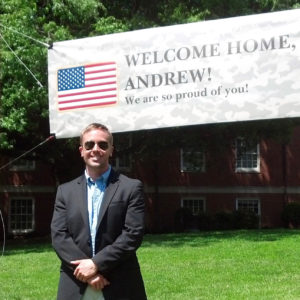 Driving back to DC, I learned that I-95 was completely closed, so I had to divert onto Route 17 in Fredericksburg and come home via I-66. Jane and I spent the rest of the evening glued to the TV. Two nights later, while commercial flights were all grounded, I awoke to hear rumblings of a vast squadron of jets flying overhead, plainly military aircraft. The feeling was eerie and unsettling. [Note: Charles and Jane could not know then that their son Andrew would soon defend our country as a Special Operations Officer. The photo shows him being welcomed home by Cherrydale Church in May 2013.]
Driving back to DC, I learned that I-95 was completely closed, so I had to divert onto Route 17 in Fredericksburg and come home via I-66. Jane and I spent the rest of the evening glued to the TV. Two nights later, while commercial flights were all grounded, I awoke to hear rumblings of a vast squadron of jets flying overhead, plainly military aircraft. The feeling was eerie and unsettling. [Note: Charles and Jane could not know then that their son Andrew would soon defend our country as a Special Operations Officer. The photo shows him being welcomed home by Cherrydale Church in May 2013.]

Sherry Corbet. I remember 9/11 very well. I was watching Good Morning America when Diane Sawyer broke in to report that a small plane had just hit one of the Twin Towers. I was struck by the shocking image. When the second plane hit the other tower, I was dumbstruck! I couldn’t believe my eyes. Then the Pentagon! I had worked in the Pentagon when we first moved to Arlington. I could well imagine how people were trapped in there! It was horrible. Later as I stood on my patio, I could see the smoke from the Pentagon. All commercial aircraft were grounded, so there were only squadrons of military jets passing overhead. I remember what a relief it was when the commercial flights returned.

Shannon Simms. On 9/11 Shannon was living on the fourth floor of an apartment building at 26 Prince Street in Manhattan, about 20 blocks from the World Trade Center. Pursuing graduate work in Media Studies at the New School, she had an interview scheduled for September 12. On the 11th she planned to buy a new suit to wear at a shop next to the Trade Center. At about 9:20 am, she got a phone call from a friend telling her “Get on your roof now!”
After climbing one flight of stairs to the roof, Shannon confronted a view of people jumping from high windows in the Twin Towers, and later, the buildings disintegrating, vivid memories to this day. On a neighbor’s television, she heard news of the attack on the Pentagon in her home town. Inspired to help, she bicycled to the Javits Center in mid-Manhattan, which she found inundated with volunteers. Soon, she would have to carry a copy of her telephone bill with her to prove that she lived on a street south of 14th Street.
By Thanksgiving, Shannon decided to return to Arlington. From her time in New York City, she recalls the smoke billowing through the streets and the smell lingering for weeks. Above all, she remembers the sense of community—city dwellers united in caring for one another. At the Lafayette Street fire station near her apartment, she participated in a candlelight vigil for firefighters who had perished in the disaster. At Union Square Park and at subway stations, she saw countless posters titled “Have You Seen?” above photos of missing loved ones.
Martha Smith. On our Tuesday walk, my friend Kathalina Stein and I were surprised when a woman burst from her house exclaiming, “a plane just hit the World Trade Center!” As soon as I got home, a friend from Houston called, informing me that the Pentagon was also hit. Before I could turn on the television, our three grown children starting calling to locate their father, who often traveled to Wall Street. Steve was in Richmond, but like Charles Horn, found returning to Arlington difficult.

Several neighbors and I were looking forward to welcoming 20 members of the Dresden Bach Choir in just a few hours. In June 2001 my brother, Joel Kirkpatrick, and I had traveled with the Houston Bach Choir through Germany “in the footsteps of Johann Sebastian Bach.” Our trip ended in Dresden, where the Houston Bach Choir and the Dresden Bach Choir presented a grand concert.
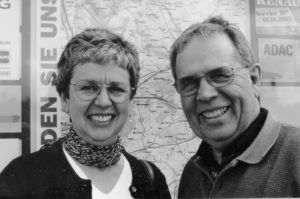
We Americans invited the Dresden singers to give a concert in Washington on September 13 and another in Houston later that week. I had found housing for many of the Dresden Choir members with several of my neighbors. But alas, their Lufthansa flight from Germany was turned around over the Atlantic Ocean. We never got to return the hospitality we had enjoyed in Dresden
Trying to preserve some sense of normalcy for my piano students, I kept my regular schedule of lessons that afternoon. That evening, I played the piano for Cherrydale’s Prayer Service. Our organist, John Haugen, lived on Capitol Hill and was unable to cross the Potomac River by car that night. I think I played a Bach Prelude and several favorite hymns—Blessed Assurance, Amazing Grace, and Abide With Me. The church was full. One of those who attended that night was Amy Haberman, a college friend of my daughter Shelby, who soon joined our church. She had called that morning saying, “May I come over? I need a family.”
Amy Haberman Mahoney. I was 23 and working for The Carlyle Group, an investment firm in DC, that was hosting its biggest conference of the year. On September 10, I had worked very late and intended to delay going in the next morning. I turned on the TV in my apartment in Rosslyn, and saw the image of the first plane hitting the tower. As more news unfolded, I called my office at 10th and Pennsylvania to see if anyone was there. Nobody answered. Nor could I get through to my parents in Connecticut or to my aunt and uncle in DC.
Rosslyn was full of tall buildings, and I was afraid that one might be a target. My roommate, a port security officer in the Coast Guard at the Navy Yard, was already at work. Looking for guidance, I called my boyfriend, (now my husband) at Little Rock Air Force base in Arkansas. He was an intelligence officer with a focus on anti-terrorism efforts. The person who answered the phone said, “we have a situation; he is busy.”
I said, “Yes. I am aware. I live two miles from the Pentagon.” She put me right through. He said “Go where you feel safe.” I called the Smiths, whom I considered my local parents. Martha said to come right over. Martha and I tried to give blood at Arlington Hospital, but the police waved us away. I remember seeing a woman in torn clothes being escorted from the hospital. We stopped at Mother’s Macaroons for a treat. Back at her house. I fell asleep on the couch, feeling safe.
One of the most chilling things I remember from watching television that day was the constant blaring sound of beacons on the firefighters’ gear. They chirp if a firefighter does not move for a while. Later reports revealed that 343 New York City firefighters died that day. I still have my copy of The Wall Street Journal from September 12, an issue assembled amidst chaos.
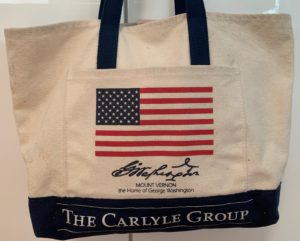
Carlyle’s investor conference at the Ritz Carlton in downtown DC ended abruptly. One officer put Canadian investors into a cab and told the cab to drive them to the Canadian border, at the firm’s expense. They walked across the border.
Rosslyn was eerily quiet for about three weeks. Absent were the planes flying directly overhead as they approached Reagan airport, often shaking the windows of our 1950s apartment. Present on Highway 110 South near the Pentagon were Humvees topped with weapons. Within a year that highway was rerouted farther from the building.
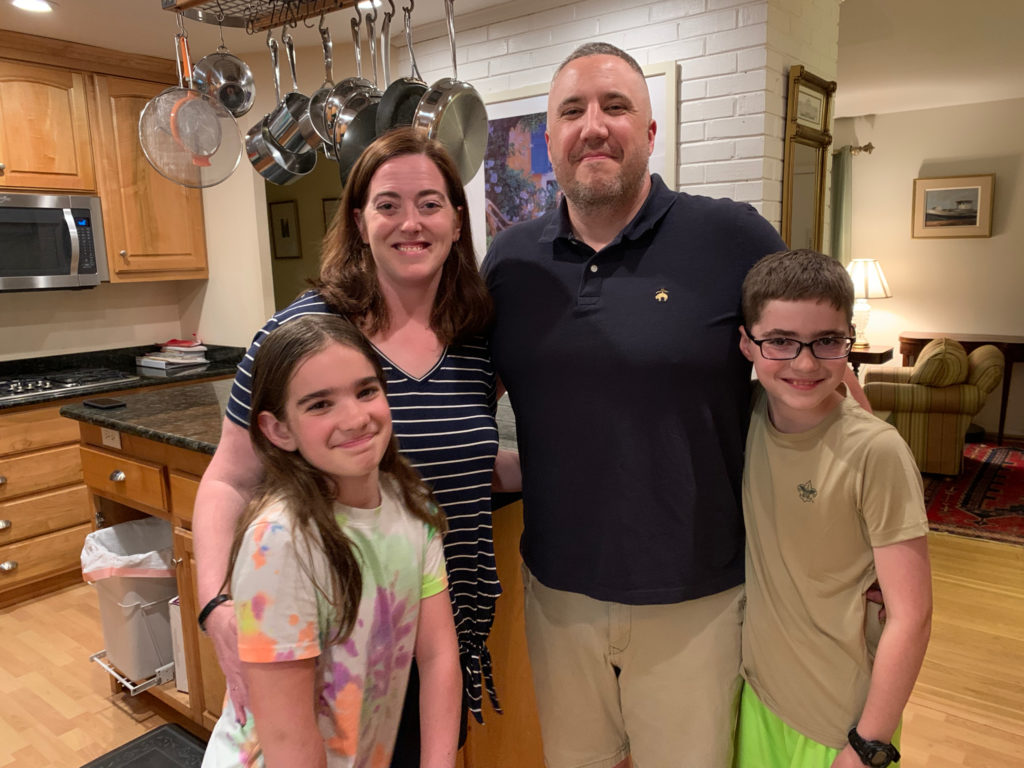
Twenty years later, in the spring of 2021, my son John is in the 5th grade at North Springfield Elementary School in Virginia. His class is putting together a time capsule to remember what 5th grade was like during the COVID pandemic. What it was like to go to school on a computer all day. What it was like to go back into the building after being out of it for a year. What it was like to wear a mask everywhere. Fifth graders in 2001 had their own “new normal”. I wonder what the “new normal” for my 5th grader will be.
Compiled and edited by Martha Smith, September, 2021
Leave a Reply